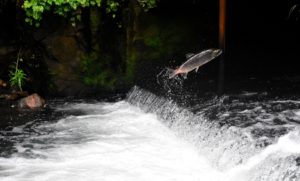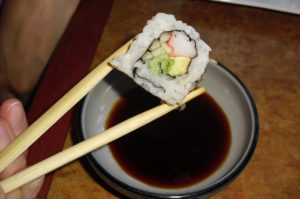GMOs show up almost everywhere in our food—even in our seafood products. If you are a savvy shopper you may wonder how a seafood product could have GMOs, since fish come directly from the ocean. Unfortunately, it is not that simple.
GMOs as an added ingredient
Many fish products we purchase contain added ingredients, which are often key GMO culprits in seafood. If you are a sushi fan, you are probably familiar with surimi, a key component in the famous California roll. Let’s look at the ingredients from two different surimi products:
| Non-GMO Project Verified Surimi | Surimi Example 2 |
| ALASKA POLLOCK, WATER, PEA STARCH, CANE SUGAR, SEA SALT, NATURAL FLAVOR, POTASSIUM CHLORIDE, COLOR ADDED (LYCOPENE FROM TOMATOES) | SURIMI 40% (FISH PROTEIN, SUGAR, STABILIZER: POLYPHOSPHATE), WATER, POTATO STARCH, EGG WHITE, RAPESEED OIL, SALT, SUGAR, FLAVORINGS (CONTAINS CRUSTACEANS AND MOLLUSKS), SOY, STABILIZER: CARRAGEENAN, MONOSODIUM GLUTAMATE, FOOD COLORINGS: TITANIUM DIOXIDE, PAPRIKA OLEORESIN, CARMINE |
When looking at the second example, you can see that it has many GMO risk ingredients. The high GMO risk ingredients could include the fish protein, sugar, rapeseed, egg whites, and soy.
| Ingredient | Potential Source | Prevalence |
| Fish protein | Farm-raised fish fed GMOs | Unknown |
| Sugar | GMO Beet Sugar | 98% of sugar beets are genetically engineered |
| Rapeseed | GMO Canola | 90% of canola is genetically engineered |
| Egg whites | Chickens fed GMOs | Very common due to the use of corn and canola meal as feed |
| Soy | GMO soybeans | 93% of soy is genetically engineered |
But unfortunately, it doesn’t stop there because many of the minor ingredients—such as flavorings and coloring—could also be derived from GMOs. Even genetically engineered fish have become a new reality for shoppers.
The GMO salmon
North American consumers have been bracing themselves for the introduction of genetically engineered salmon into the marketplace for several years. To appease shoppers, Whole Foods, Trader Joe’s, Target, Kroger, Costco, Safeway, Albertsons, Aldi, and more than 60 other chains (over 11,000 stores in total) have promised not to sell AquAdvantage salmon. Despite this opposition, unlabeled engineered salmon entered the Canadian marketplace in 2017 without any shopper awareness. While Aquabounty—the company behind the GMO salmon—continues to face regulatory hurdles in the United States, it is anticipated to be in the marketplace as early as 2020.
The GMO salmon was engineered to grow twice as fast as other farmed Atlantic salmon. This fish contains DNA from three different types of fish: Atlantic salmon, Chinook salmon, and the eel-like ocean pout. Like other GMOs, these fish are experimental.
There are a number of concerns with these salmon. For one, DNA is incredibly dynamic, and when DNA is inserted or deleted there can be off-target impacts. This is one reason it takes so many years to create GMOs. Scientists are continually needing to navigate around the unintended consequences of the insertions they make in the genetic engineering process. Understandably, many consumers are choosing to opt-out of eating these experimental foods.
Another pressing concern is the risk of releasing the salmon into the natural environment. These living GMOs are bred to be sterile and female in hopes of preventing them from mixing with wild populations. However, consumers have cause to be concerned. It was announced in September 2019 that genetically engineered mosquitoes—supposedly not capable of producing viable offspring—have passed on genes to the native mosquito population in Brazil. This is highly concerning, particularly as salmon plays an integral part in the well-being of so many people and animals.
Farm-raised fish
There was a well received movie several years ago called GMO OMG. In the movie, there is a poignant scene where the filmmaker, Jeremy Seifert, takes his son to fish for trout in a mountain lake. He knows that the fish in the lake are stocked earlier in the season. However, as his son is catching his fish, he becomes curious about the diet of the farm-raised fish. He soon discovers that GMO ingredients are a primary component of the pellets fed to farm-raised fish.
This is why the Non-GMO Project evaluates feed in its verification process. The majority of soy, corn, and canola are genetically engineered and, unfortunately, they show up in all types of animal feed—including fish feed. When you purchase Verified seafood products, you can trust that the feeds used to produce farm-raised fish are compliant with the Non-GMO Project Standard.
Non-GMO Project Verified Seafood
The Non-GMO Project is unparalleled in the rigor of its Standard. In fact, the organization is one of the only certifications that evaluates the feed of the animals it verifies. As you navigate the seafood aisle, keep a look out for the Non-GMO Project Butterfly, and know that we are continually working to bring consumers greater ingredient integrity and transparency. Check out our downloadable infographic for further information about GMOs in seafood.
Thank you to Trans-Ocean for sponsoring our Seafood Education week. We appreciate their ongoing commitment to GMO transparency and product integrity.
About Trans-Ocean Products, Inc.
Trans-Ocean is America’s #1 brand of surimi seafood and the proud producer of Simply Surimi, made with all natural, non-GMO ingredients in our certified gluten-free facility in Bellingham, WA.
What inspired Trans-Ocean to pursue Non-GMO Project verification?
Our Simply Surimi brand was developed for consumers who desire clean-labeled foods that are made with all-natural ingredients. As a seafood industry leader, we believe we have a responsibility to our customers, consumers, and our local community to sustainably produce foods that are safe, nutritious and made in harmony with the natural environment.
Learn about new GMOs.

